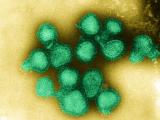Nov 9, 2011
UK 'Flusurvey' joins European network
The UK's Flusurvey, begun in 2009, will this year join a European network of online surveys to gather information on how influenza spreads across the continent and enable between-nation comparisons. "For the first time, we will be able to compare cases across the continent as flu spreads through Europe," said Sebastian Funk of the London School of Hygiene & Tropical Medicine (LSHTM), one of the Flusurvey's founders, in an LSHTM press release yesterday. "This provides a fascinating opportunity to understand the dynamics of seasonal flu on a large scale." John Edmunds, another founder, said, "We set up the Flusurvey to allow the public to report their illness directly. Anyone can take part." Up to 5,000 people have taken the survey in previous years.
Nov 8 LSHTM news release
Flusurvey home page
New H1N1 group found circulating in Spain
Pandemic 2009 H1N1 influenza (pH1N1) viruses circulating in Spain last flu season included a new genetic group, but none of the viruses studied show any significant antigenic changes, according to a phylogenetic analysis in the Journal of Clinical Virology. Spanish researchers analyzed 220 circulating pH1N1 viruses from Spanish Influenza Surveillance System labs. They found six different genetic groups, five of which were previously noted. The new group they identified constituted 12.3% of the viruses and was characterized by E172K and K308E changes and a prolinea type of amino acidat position 83 of the hemagglutinin protein. The authors conclude, "None of the groups identified to date have resulted in significant antigenic changes."
Nov 8 J Clin Virol abstract
Study: Modest antibody response with H1N1 vaccine in immunocompromised
Brazilian researchers found that seroconversion rates in immunocompromised patients, including the elderly, 3 weeks after pH1N1 immunization generally ranged under 56% and seroprotection rates generally under 62%, according to a study in PLoS One. They studied 319 patients with cancer, 260 with rheumatoid arthritis (RA), 256 with HIV, 149 elderly patients, 85 kidney transplant recipients, and 83 with juvenile idiopathic arthritis (JIA). Seroprotection, seroconversion, and geometric mean titer ratios postvaccination were, respectively: 37.6%, 31.8%, and 3.2 for kidney transplant patients; 61.5%, 53.1%, and 7.5 for RA patients; 63.1%, 55.7%, and 5.7 in the elderly; 59.0%, 54.7%, and 5.9 in HIV patients; and 52.4%, 49.2%, and 5.3 in cancer patients. Bucking the trend were the JIA patients, whose numbers were 85.5%, 78.3%, and 16.5. The authors defined seroprotection as postvaccination
hemagglutination-inhibition (HI) antibody titers of 1:40 or greater and seroconversion as HI antibody titer prevaccination less than 1:10 and postvaccination 1:40 or greater, or prevaccination 1:10 or greater, along with a fourfold or greater antibody increase. Guidance from the US Centers for Disease Control and Prevention for health professionals states that serology may overestimate flu vaccine efficacy.
Nov 8 PLoS One study
CDC flu vaccine guidance



















